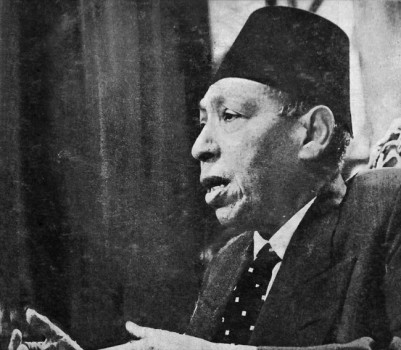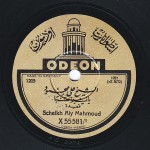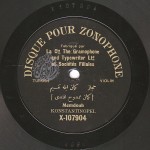The Arab Music Archiving and Research foundation (AMAR), in collaboration with the Sharjah Art Foundation (SAF), presents “Niẓāmunā al-Mūsīqī”.
Dear listeners,
Welcome to a new episode of “Niẓāmunā al-Mūsīqī”.
Today, we will be resuming with Mr Mustafa Said our discussion about taqsīm-s (modal improvisation) and a practical way to master and produce good taqsīm-s.
Is there a way to teach taqsīm-s?
Yes, there is: it consists in memorising a significant repertoire of musical works pertaining to the concerned musical system that includes the taqsīm, and thus acquiring the ability to interpret it, and studying meters and taf‘īla-s (trochee-s), and thus acquiring the ability to translate this into phrases. All this is achieved by learning.
Let us go back to the subject of the repertoire. Does it have to be a repertoire of taqsīm-s or of everything?
Not at all.
Everything.
Everything. In fact, that which must be the least memorised is taqsīm. It is enough to listen to those, yet one must memorise the instrumental pieces including samā‘ī-s (instrumental overture-s), bashraf-s (pre-composed instrumental fixed and metrical cyclic composition-s), lāzima-s (refrain-s), taḥmīla-s (cyclic instrumental improvisative responsorial form to a binary rhythm), dūlāb-s (binary metrical brief instrumental prelude-s)… all the forms, whether they are known or not, or rather all the instrumental pieces whether they are forms or not, and memorise songs such as dawr-s (Egyptian vocal form) and muwashshaḥ-s (plurimetric and plurirhyme Arabic poem) and be able to sing them accompanied by his instrument.
Followed by the taqsīm-s.
Then one studies the taf‘īla-s and the baḥr-s (poetry meter-s)…etc. until one is able to produce phrases that are taqsīm-s.
Performing taqsīm is inventing/creating. One can’t perform good taqsīm-s and not know how to invent/create. A man can’t be a professional instrumentalist and perform good taqsīm-s, but produce bad musical compositions. Taqsīm is composition, yet on-the-spot composition. A piece composed to a certain rhythmic cycle can’t be created if its composer does not master taf‘īla-s, baḥr-s, …etc. …There will surely be lacks …
(♩)
You tackle the subject of taqsīm-s and music based on the principle that music reflects its language. Language consists in syllables… In our case, poetry consists in taf‘īla-s and baḥr-s. You are talking about the same taf‘īla-s used in poetry…
Yes… Well, in language’s meters in general, not only in poetry, i.e. not necessarily ‘arūḍ (Arabic prosody).
Yet it would be great if one could also sing to the baḥr-s, this would be marvellous! Still, it must be done with taf‘īla-s but not necessarily with ‘arūḍ.
So, you are extending to the known taf‘īla-s: fā‘ilun, fa‘ūlun, mustaf‘ilun,
…fā‘ilātun, mafā‘īlun…etc.
And fā‘ilun…etc.
You are extending from these taf‘īla-s… Will the taf‘īla-s be useful?
Exactly.
Because they are applicable to language, like the words’ meter in language, including the ṣāmit (non-vowel mark) and the mutaḥarrik (accented with a vowel mark). You are now extending to more taf‘īla-s.
Even if we go beyond the issue of taf‘īla-s, there is the issue of the sabab and the watad (long vowel and short vowel).
I.e. mutaḥarrik (accented with a vowel mark) and mutaḥarrik sākin (accented with a non-vowel mark)…
Exactly.
Mutaḥarrik sākin (accented with a non-vowel mark) or mutaḥarrik mutaḥarrik (accented with a vowel mark).
The rhythm’s cadence is built upon the sabab and the watad that one can also call “tanan tā”, or 1, 2, 3, 1,2…etc.
Tacademy.
For example… you can call it what you like. It does not matter …
(♩)
Can you illustrate what you have explained?
For example, there is …
(♩)
It would be great to be able to take one letter, one string, and produce taf‘īla-s …
(♩)
You try to extend them …
(♩)
You increase the letters until you get there. You could even decide to select a baḥr, for example mustaf‘ilun fā‘ilun…etc. …
(♩)
All these silences are on one string… and it is enough.
So, it is an organised attempt.
Exactly.
Then the musician performs taqsīm on more than one letter: he selects a taf‘īla and only three or four letters.
On one string.
Yes.
He focuses on the segmentation of the rhythm and not on the maqām (musical mode).
Being able to do this added to the acquired repertoire is a great achievement.
(♩)
Dear listeners,
We have reached the end of today’s episode of “Niẓāmunā al-Mūsīqī” presented to you by Fadil al-Turki and Mr Mustafa Said.
We will meet again soon.
“Niẓāmunā al-Mūsīqī” is brought to you by Mustafa Said.
- 221 – Zakariyya Ahmed – 12 (1/9/2022)
- 220 – Zakariyya Ahmed – 11 (1/9/2022)
- 219 – Zakariyya Ahmed – 10 (11/25/2021)
- 218 – Zakariyya Ahmed – 9 (10/26/2021)
- 217 – Zakariyya Ahmed – 8 (9/24/2021)
- 216 – Zakariyya Ahmed – 7 (9/4/2021)
- 215 – Zakariyya Ahmed – 6 (8/28/2021)
- 214 – Zakariyya Ahmed – 5 (8/6/2021)
- 213 – Zakariyya Ahmed – 4 (6/26/2021)
- 212 – Zakariyya Ahmed – 3 (5/27/2021)
- 211 – Zakariyya Ahmed – 2 (5/1/2021)
- 210 – Zakariyya Ahmed – 1 (4/28/2021)
- 209 – W-al-Lāhi lā astaṭī‘u ṣaddak 2 (4/6/2017)
- 208 – W-al-Lāhi lā astaṭī‘u ṣaddak 1 (3/30/2017)
- 207 – Bashraf qarah baṭāq 7 (3/23/2017)



